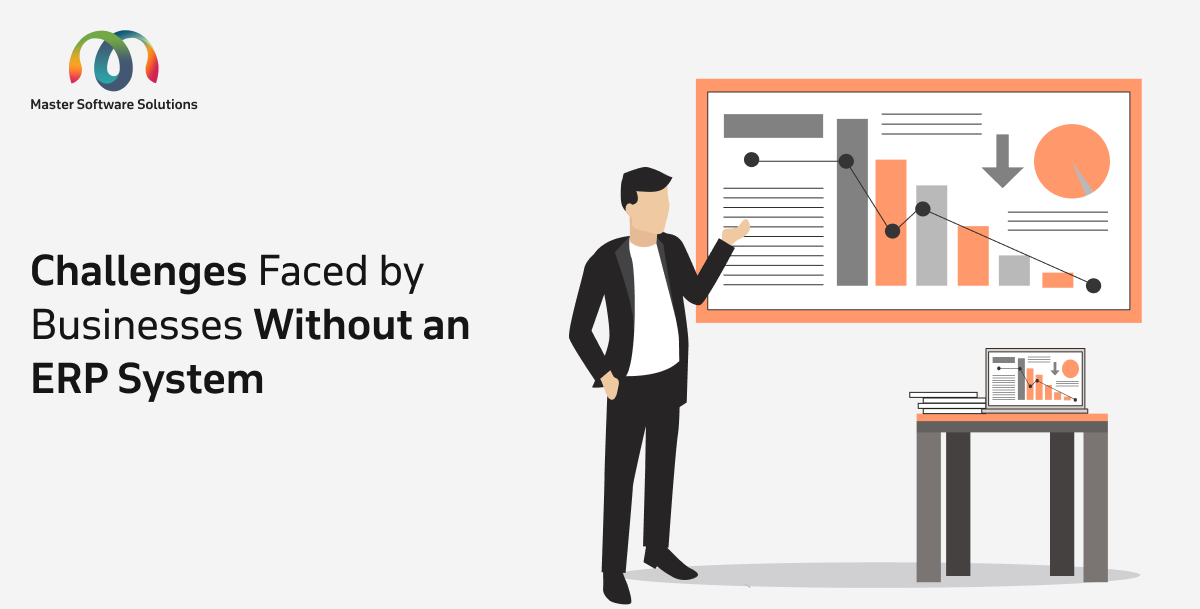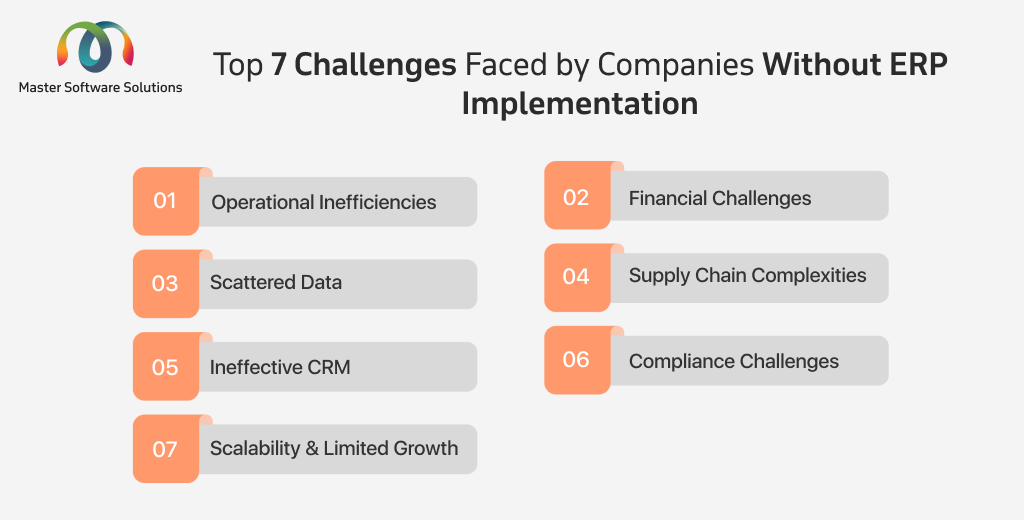Managing small businesses is easy with multiple systems or manually. However, as your business grows, managing customer data, financial data, order data, and manufacturing data becomes time- and effort-consuming in a large database. If you have not invested in ERP implementation, now is the perfect time.
What is ERP? – ERP stands for enterprise resource planning. It is a suite of systems that integrates core business processes, including manufacturing, accounting, finance, HR, distribution, sales and marketing, and human resources.
This blog discusses and highlights the common challenges faced by businesses with an ERP system.
Top 7 challenges commonly faced by companies without an ERP implementation
In today’s business landscape, companies focus on enhancing efficiency, streamlining operations, and staying competitive. Doing so requires streamlined and optimized processes, which is impossible without a comprehensive ERP system. These are common challenges businesses face without an ERP:
Operational inefficiencies
Many businesses still rely on manual methods, such as spreadsheets, paper records, or disconnected systems, to manage their routine operations. While this approach may be suitable for smaller businesses, it often leads to significant operational inefficiencies, ultimately harming productivity and profitability.
- Without automation, processes such as order entry, inventory management updates, invoicing, or production planning are time-consuming. There is no centralized platform, which can lead to data discrepancies, delays in decision-making, and even lost or outdated information. Your employees spend hours chasing down data instead of focusing on value-adding tasks.
- Manual data entry leads to more human errors in inventory counts, invoices, and financial reports. These errors can result in financial discrepancies, incorrect shipments, or delayed deliveries, reducing customer satisfaction and business credibility. This can even slow down your order-to-cash cycle, making financial reporting time-consuming and limiting the visibility of overall cash flow and decision-making.
- Performing repetitive tasks such as creating reports, tracking orders, or updating stock levels is time-consuming. Resources, including human resources, inventory, and time, are inefficiently used, resulting in work overload or underperformance. Over time, this can contribute to employee burnout, decreased morale, and increased operational costs.
Financial challenges
Financial management is often handled using manual processes, spreadsheets, or disconnected financial tools in growing businesses. While this may seem manageable at first, it can quickly become a source of serious issues that impact accuracy, transparency, and strategic decision-making.
- Human errors, ranging from typos to miscalculations, can occur during manual data entry. Monthly or quarterly reports are delayed due to the time to gather and verify data from various departments. As a result, leaders make decisions based on outdated or incomplete financial information, impacting business planning and growth.
- Using multiple tools or systems for operations, such as accounting, payroll, invoicing, and expense tracking, often leads to inconsistent data. For instance, a transaction recorded on the sales systems may not sync properly with the accounting software. These inconsistencies necessitate manual reconciliation, which wastes time and increases the likelihood of financial discrepancies.
- Gathering financial data from various departments is a time-consuming, labor-intensive, and error-prone process. The lack of integration between departments, including sales, procurement, and finance, can cause communication breakdowns, resulting in missing or incomplete data. Your financial teams have to spend more time tracking down the information than analyzing it.
- It is challenging to get a real-time snapshot of your cash flow, profitability, or expenses without a centralized system. The lack of visibility affects budgeting, forecasting, and investment decisions. This results in businesses reacting to financial issues instead of proactively planning for them.
Scattered data
Various departments use different tools, including outdated legacy systems or operation-specific software solutions for inventory, payments, and order management. These tools serve their purpose; however, they create data silos and disconnected workflows that hurt overall business performance.
- Each system stores data differently, making it difficult to consolidate information accurately. For instance, customer names may differ in your order system from your payment system. This creates confusion and increases the risk of duplication or data misinterpretation.
- Businesses rely on middleware or external integration tools to collect all of the information, which results in increased costs, potential technical issues, and integration delays. Even with integrations, real-time data synchronization remains challenging and can lead to data inconsistencies. This can lead to miscommunication, slow processes, and duplicate efforts, as teams can’t collaborate effectively on shared goals.
- Without a unified data source, leaders lack a clear, up-to-date picture of the business. This delays strategic decisions and makes enterprises less responsive to market changes. It also leads to outdated insights being used for planning, which can make strategies ineffective or even counterproductive.
Supply chain complexities
Managing supply chains and inventory manually or using disconnected tools can result in inefficiencies and operational risks. Without a centralized system, businesses often struggle with real-time visibility, data accuracy, and demand forecasting, leading to costly disruptions.
- Manually updating inventory or using multiple unconnected tools results in inaccurate data, leading to overstocking and stockouts. These errors can create gaps between supply and demand, affecting your business performance.
- Without real-time inventory insights, anticipating how much stock to reorder or when results in missed opportunities or product spoilage. Holding excessive or insufficient stock increases operational costs and reduces profitability.
- A fragmented system can’t provide an up-to-date view of inventory movement or supply chain activities. You might not know where your products are, their arrival time, or if supplier delays will impact your operations. The lack of real-time visibility prevents proactive decision-making during disruptions or demand spikes.
- The inability to fulfill customer orders or consistently stock the right products erodes customer trust. This can lead to delayed deliveries, canceled orders, or poor product availability, which reduces customer experience and loyalty.
Ineffective CRM
Managing customer relationships manually or via disconnected tools makes it difficult to deliver the kind of personalized, timely, and consistent experiences customers expect. Customer relationship management includes marketing, sales, and customer service. Any inefficiencies in these areas can lead to lost opportunities and weaken loyalty.
- Without a centralized system, customer data is often stored in spreadsheets or isolated systems, resulting in incomplete or inaccurate profiles. This makes it difficult to provide personalized interactions based on previous purchases, preferences, or behavior.
- Improper customer interactions aren’t properly tracked across departments; teams can miss follow-ups, send duplicate messages, or offer outdated information. These communication errors lead to inconsistent experiences and reduced trust. Opportunities for customer engagement are missed, resulting in lower customer loyalty and conversion rates.
Compliance challenges
Operating in any regulated industry, such as food and beverage, healthcare, manufacturing, or logistics, requires strict adherence to industry standards, laws, and safety protocols. It is overwhelming and risky to manage compliance without a proper system, threatening the business’s continuity.
- The regulatory environment varies across industries and regions and is often complex and frequently updated. Relying on manual research and tracking increases the chances of misinterpreting regulations or missing changes. This can result in unaware violations, even if the business is trying to stay compliant.
- Compliance entails documentation, reporting, certifications, and audit trails, all of which are time-consuming and prone to errors when done manually. A small oversight can lead to a missed inspection deadline or an incomplete report, resulting in regulatory breaches.
- Most businesses, especially SMEs, lack dedicated compliance teams or the tools to monitor activities efficiently. Without automation, tracking tasks like safety checks, environmental standards, or employee training becomes resource-intensive and unsustainable. Compliance becomes a reactive process rather than a proactive one.
- Failing to meet regulatory compliance can lead to penalties, legal actions, and operational shutdowns. This can damage your reputation with customers, partners, and regulators. Repeated noncompliance results in license revocation, reduced investor confidence, and long-term damage to your brand and business stability.
Scalability and limited growth
As your business grows, adding more customers, employees, products, or locations, your technology should also grow. However, fragmented, inflexible systems become a hurdle instead of a support structure. They lack the flexibility and scalability needed to handle increasing complexity and data volumes.
- Legacy or disconnected systems can not handle large volumes of data or multi-department operations. As the data increases, these systems slow down, making day-to-day operations inefficient. This affects user experience, productivity, and your ability to respond quickly to business needs.
- Many older systems have fixed storage limits or require manual upgrades. With increasing data for inventory, sales records, customer interactions, and employee records, you can hit capacity limits, causing the systems to crash or data loss. The inability to scale forces you to add more disconnected tools, worsening the fragmentation.
- Outdated systems are rigid and difficult to customize for your evolving business processes. Integrating them with the latest technologies is complex, expensive, and even impossible. This can slow down digital transformation efforts and limit innovation abilities or responses to market changes.
Bottom-line
These challenges without ERP are real and can significantly hinder growth and productivity. An enterprise resource planning system is a comprehensive platform that enables small and medium enterprises and larger organizations to manage and track their entire operations. There are various ERP platforms available, such as Odoo and Microsoft Dynamics 365.
Master Software Solutions is an IT service-based company that provides ERP consulting services, including implementation, migration from legacy systems, upgrading existing ERP systems, integrations, and system customizations. We work on Odoo ERP and Microsoft Dynamics 365 to provide tailored solutions for your business.

